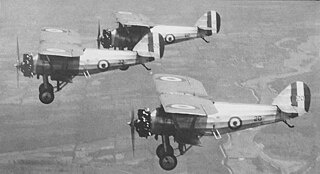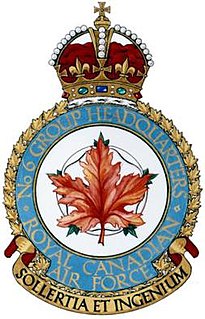Related Research Articles
The history of the Royal Canadian Air Force begins in 1920, when the air force was created as the Canadian Air Force (CAF). In 1924 the CAF was renamed the Royal Canadian Air Force (RCAF) when it was granted the royal title by King George V. The RCAF existed as an independent service until 1968. Prior attempts at forming an air force for Canada were the Canadian Aviation Corps that was attached to the Canadian Expeditionary Force, and a two-squadron Canadian Air Force that was attached to the Royal Air Force.

The Armstrong Whitworth Siskin was a British biplane single-seat fighter aircraft of the 1920s produced by Armstrong Whitworth Aircraft. The Siskin was one of the first new RAF fighters to enter service after the First World War, and was noted for its aerobatic qualities.

The Avro Canada CF-100 Canuck is a Canadian twinjet interceptor/fighter designed and produced by aircraft manufacturer Avro Canada. It has the distinction of being the only Canadian-designed fighter to enter mass production.

The Royal Canadian Air Force is the air force of Canada. Its role is to "provide the Canadian Forces with relevant, responsive and effective airpower". The RCAF is one of three environmental commands within the unified Canadian Armed Forces. As of 2013, the Royal Canadian Air Force consists of 14,500 Regular Force and 2,600 Primary Reserve personnel, supported by 2,500 civilians, and operates 258 manned aircraft and 9 unmanned aerial vehicles. Lieutenant-General Al Meinzinger is the current Commander of the Royal Canadian Air Force and Chief of the Air Force Staff.

The Golden Centennaires were a Royal Canadian Air Force (RCAF) aerobatic flying team that performed in 1967, the Canadian Centennial year. The team was created to celebrate the Canadian Centennial.

No. 1 Group of the Royal Air Force is one of the two operations groups in RAF Air Command. Today, the group is referred to as the Air Combat Group, as it controls the RAF's combat fast-jet aircraft and has airfields in the UK, as well as RAF Support Unit Goose Bay in Canada. The group headquarters is located alongside Headquarters Air Command at RAF High Wycombe, Buckinghamshire. The other operational group is No. 2 Group RAF.

Canadian Forces Base Trenton, formerly RCAF Station Trenton, is a Canadian Forces base located within the city of Quinte West, Ontario. It is operated as an air force base by the Royal Canadian Air Force (RCAF) and is the hub for air transport operations in Canada and abroad. Its primary RCAF lodger unit is 8 Wing, commonly referred to as 8 Wing Trenton. CFB Trenton is Canada's largest Air Force base.

The Canadair CL-44 was a Canadian turboprop airliner and cargo aircraft based on the Bristol Britannia that was developed and produced by Canadair in the late 1950s and early 1960s. Although innovative, only a small number of the aircraft were produced for the Royal Canadian Air Force (RCAF), and for commercial operators worldwide.

Zweibrücken Air Base was a NATO military air base in West Germany. It was located 35 miles SSW of Kaiserslautern and 2 miles mi SE of Zweibrücken. It was assigned to the Royal Canadian Air Force (RCAF) and the United States Air Forces in Europe (USAFE) during its operational lifetime.

408 Tactical Helicopter Squadron is a unit of 1 Wing, Kingston. It is co-located with 1 Canadian Mechanized Brigade Group at Canadian Forces Base (CFB) Edmonton.

No. 6 Group RCAF was a group of Royal Canadian Air Force (RCAF) heavy bomber squadrons in Europe during the Second World War, between 1942 and 1945. The group operated out of airfields in Yorkshire, England.

Royal Air Force Station Langar or more simply RAF Langar is a former Royal Air Force station located near the village of Langar, Nottinghamshire, England. The airfield is located approximately 6 miles (9.7 km) east-southeast of Radcliffe on Trent and about 100 miles (160 km) north-northwest of London, England.

The Canadian Air Force (CAF) was a contingent of two Canadian air force squadrons – one fighter and one bomber – authorized by the British Air Ministry in August 1918 during the close of the First World War. The unit was independent from the Canadian Expeditionary Force and the Royal Air Force (RAF).

No. 428 Squadron RCAF, also known as 428 Bomber Squadron, and 428 Ghost Squadron, was first a night bomber squadron in the Royal Canadian Air Force engaged in strategic bombing during World War II, as based in Yorkshire. At the end of the war the squadron moved to Nova Scotia before being disbanded in September 1945. In 1954 the squadron was reformed as 428 All-Weather (Fighter) Squadron, before being again disbanded in 1961.

429 Transport Squadron of the Royal Canadian Air Force is one of four squadrons attached to CFB Trenton in Trenton, Ontario. The squadron was originally formed as a bomber squadron of the Royal Canadian Air Force (RCAF) attached to RAF Bomber Command during the Second World War.

No. 162 Squadron RCAF was a unit of the Royal Canadian Air Force. Formed as a bomber reconnaissance squadron at RCAF Station Yarmouth, Nova Scotia, Canada on 19 May 1942 with Canso A aircraft, the squadron spent an uneventful eighteen months on east coast anti-submarine duty. In January 1944 it was seconded to RAF Coastal Command and stationed at RAF Reykjavik, Iceland to cover the mid-ocean portion of the North Atlantic shipping route.

The Avro Canada CF-103 was a proposed Canadian interceptor, designed by Avro Canada in the early 1950s as a development, and possible replacement of the company's CF-100 Canuck, that was entering service at the time with the Royal Canadian Air Force (RCAF). Although intended to be capable of flying at transonic speeds, the CF-103 only offered a moderate increase in performance and capability over the CF-100; subsequently, the aircraft never progressed beyond the mock-up stage.
The Royal Canadian Air Force Overseas Headquarters, often abbreviated to RCAF Overseas, was responsible for Canadian airmen serving outside Canada during and just after World War II. The headquarters was established on 1 January 1940 and it was based in London. Its main functions were to conduct liaison with the British Air Ministry, to provide a central location for personnel records, and provide general administration. As the War progressed, the Overseas Headquarters gained increasing administrative authority over Canadian personnel but never gained any significant operational responsibility for RCAF units and formations which were integrated into the RAF's command structure.
No. 2 Squadron was a Royal Canadian Air Force (RCAF) squadron active during the late 1930s. The squadron operated army cooperation aircraft from 1935, and upon the outbreak of World War II was selected for overseas duty. However, a shortage of aircraft forced its disbandment in late 1939 to reinforce two other squadrons.
References
- Larry Milberry (1984). Sixty years: the RCAF and CF Air Command 1924-1984. Toronto: Canav Books. ISBN 0-9690703-4-9.
- E.T. Karkut (1999). The History of the 6RD Aerospace Maintenance Development Unit. Boston Mills Press. ISBN 0-919783-96-1.
- C. L. ANNIS, OBE (Summer 2008). "The Evolution of Air Materiel Command" (PDF). The Canadian Air Force Journal.